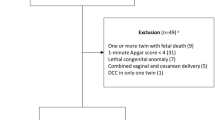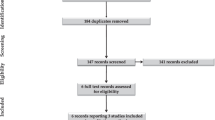Abstract
Objective:
To investigate the safety, feasibility and efficacy of delayed cord clamping (DCC) compared with immediate cord clamping (ICC) at delivery among infants born at 22 to 27 weeks’ gestation.
Study Design:
This was a pilot, randomized, controlled trial in which women in labor with singleton pregnancies at 22 to 27 weeks’ gestation were randomly assigned to ICC (cord clamped at 5 to 10 s) or DCC (30 to 45 s).
Results:
Forty mother–infant pairs were randomized. Infants in the ICC and DCC groups had mean gestational ages (GA) of 24.6 and 24.4 weeks, respectively. No differences were observed between the groups across all available safety measures, although infants in the DCC group had higher admission temperatures than infants in the ICC group (97.4 vs 96.2 °F, P=0.04). During the first 24 h of life, blood pressures were lower in the ICC group than in the DCC group (P<0.05), despite a threefold greater incidence of treatment for hypotension (45% vs 12%, P<0.01). Infants in the ICC group had increased numbers of red blood transfusions (in first 28 days of life) than infants in DCC group (4.1±3.9 vs 2.8±2.2, P=0.04).
Conclusion:
Among infants born at an average GA of 24 weeks’, DCC appears safe, logistically feasible, and offers hematological and circulatory advantages compared with ICC. A more comprehensive appraisal of this practice is needed.
This is a preview of subscription content, access via your institution
Access options
Subscribe to this journal
Receive 12 print issues and online access
$259.00 per year
only $21.58 per issue
Buy this article
- Purchase on Springer Link
- Instant access to full article PDF
Prices may be subject to local taxes which are calculated during checkout


Similar content being viewed by others
References
Ononeze ABO, Hutchon DJR . Attitude of obstetricians towards delayed cord clamping: a questionnaire-based study. J Obstet Gynaecol 2009; 29 (3): 223–224.
Maughan KL, Heim SW, Galazka SS . Preventing postpartum hemorrhage: managing the third stage of labor. Am Fam Physician 2006; 73 (6): 1025–1028.
Prendiville WJ, Elbourne D, McDonald S . Active versus expectant management in the third stage of labour. Cochrane Database Syst Rev 2000; (3): CD000007.
Baenziger O, Stolkin F, Keel M, von Siebenthal K, Fauchere JC, Das Kundu S et al. The influence of the timing of cord clamping on postnatal cerebral oxygenation in preterm neonates: a randomized, controlled trial. Pediatrics 2007; 119 (3): 455–459.
Mercer JS, Vohr BR, McGrath MM, Padbury JF, Wallach M, Oh W . Delayed cord clamping in very preterm infants reduces the incidence of intraventricular hemorrhage and late-onset sepsis: a randomized, controlled trial. Pediatrics 2006; 117 (4): 1235–1242.
Mercer JS, McGrath MM, Hensman A, Silver H, Oh W . Immediate and delayed cord clamping in infants born between 24 and 32 weeks: a pilot randomized controlled trial. J Perinatol 2003; 23 (6): 466–472.
Rabe H, Diaz-Rossello JL, Duley L, Dowswell T . Effect of timing of umbilical cord clamping and other strategies to influence placental transfusion at preterm birth on maternal and infant outcomes. Cochrane Database Syst Rev 2012; 8: CD003248.
Strauss RG, Mock DM, Johnson KJ, Cress GA, Burmeister LF, Zimmerman MB et al. A randomized clinical trial comparing immediate versus delayed clamping of the umbilical cord in preterm infants: short-term clinical and laboratory endpoints. Transfusion 2008; 48 (4): 658–665.
AAP. Timing of umbilical cord clamping after birth. Pediatrics 2013; 131 (4): e1323.
Gynecology AACoOa. Committee opinion no.543: timing of umbilical cord clamping after birth. Obstet Gynecol 2012; 120 (6): 1522–1526.
WHO Guidelines on Basic Newborn Resuscitation 2012. World Health Organization Press: : Geneva, 2012.
Katheria AC, Truong G, Cousins L, Oshiro B, Finer NN . Umbilical cord milking versus delayed cord clamping in preterm infants. Pediatrics 2015; 136 (1): 61–69.
Bell MJ, Ternberg JL, Feigin RD, Keating JP, Marshall R, Barton L et al. Neonatal necrotizing enterocolitis. Therapeutic decisions based upon clinical staging. Ann Surg 1978; 187 (1): 1–7.
Papile LA, Burstein J, Burstein R, Koffler H . Incidence and evolution of subependymal and intraventricular hemorrhage: a study of infants with birth weights less than 1,500 gm. J Pediatr 1978; 92 (4): 529–534.
Oh W, Fanaroff AA, Carlo WA, Donovan EF, McDonald SA, Poole WK et al. Effects of delayed cord clamping in very-low-birth-weight infants. J Perinatol 2011; 31 (suppl): S68–S71.
Tarnow-Mordi WO, Duley L, Field D, Marlow N, Morris J, Newnham J et al. Timing of cord clamping in very preterm infants: more evidence is needed. Am J Obstet Gynecol 2014; 211: 118–123.
Jelin AC, Kuppermann M, Erickson K, Clyman R, Schulkin J . Obstetricians' attitudes and beliefs regarding umbilical cord clamping. J Matern Fetal Neonatal Med 2013; 11: 11.
Aladangady N, McHugh S, Aitchison TC, Wardrop CA, Holland BM . Infants' blood volume in a controlled trial of placental transfusion at preterm delivery. Pediatrics 2006; 117 (1): 93–98.
McDonnell M, Henderson-Smart DJ . Delayed umbilical cord clamping in preterm infants: a feasibility study. J Paediatr Child Health 1997; 33 (4): 308–310.
Katheria A, Blank D, Rich W, Finer N . Umbilical cord milking improves transition in premature infants at birth. PloS One 2014; 9 (4): e94085.
Katheria AC, Leone TA . Changes in hemodynamics after rescue surfactant administration. J Perinatol 2013; 33 (7): 525–528.
Ersdal HL, Linde J, Mduma E, Auestad B, Perlman J . Neonatal outcome following cord clamping after onset of spontaneous respiration. Pediatrics 2014; 134 (2): 265–272.
Nevill E, Meyer MP . Effect of delayed cord clamping (DCC) on breathing and transition at birth in very preterm infants. Early Hum Dev 2015; 91 (7): 407–411.
Hosono S, Mugishima H, Fujita H, Hosono A, Minato M, Okada T et al. Umbilical cord milking reduces the need for red cell transfusions and improves neonatal adaptation in infants born at less than 29 weeks' gestation: a randomised controlled trial. Arch Dis Child Fetal Neonatal Ed 2008; 93 (1): F14–F19.
Hutchon DJ, Thakur I . Resuscitate with the placental circulation intact. Arch Dis Child 2008; 93 (5): 451.
Pushpa-Rajah A, Bradshaw L, Dorling J, Gyte G, Mitchell EJ, Thornton J et al. Cord pilot trial - immediate versus deferred cord clamping for very preterm birth (before 32 weeks gestation): study protocol for a randomized controlled trial. Trials 2014; 15: 258.
Oddie S, Rhodes P, on behalf of the 'Very Preterm Birth Qualitative Collaborative G. Barriers to deferred cord clamping in preterm infants. Arch Dis Child Fetal Neonatal Ed 2014; 99: F391–F394.
McCall EM, Alderdice F, Halliday HL, Jenkins JG, Vohra S . Interventions to prevent hypothermia at birth in preterm and/or low birthweight infants. Cochrane Database Syst Rev 2010; (3): CD004210.
Laptook AR, Salhab W, Bhaskar B, Neonatal Research N. Admission temperature of low birth weight infants: predictors and associated morbidities. Pediatrics 2007; 119 (3): e643–e649.
DeMauro SB, Douglas E, Karp K, Schmidt B, Patel J, Kronberger A et al. Improving delivery room management for very preterm infants. Pediatrics 2013; 132 (4): e1018–e1025.
March MI, Hacker MR, Parson AW, Modest AM, de Veciana M . The effects of umbilical cord milking in extremely preterm infants: a randomized controlled trial. J Perinatol 2013; 33 (10): 763–767.
Christensen RD, Baer VL, Del Vecchio A, Henry E . Unique risks of red blood cell transfusions in very-low-birth-weight neonates: associations between early transfusion and intraventricular hemorrhage and between late transfusion and necrotizing enterocolitis. J Matern Fetal Neonatal Med 2013; 26 (Suppl 2): 60–63.
Munro MJ, Walker AM, Barfield CP . Hypotensive extremely low birth weight infants have reduced cerebral blood flow. Pediatrics 2004; 114 (6): 1591–1596.
Watkins AM, West CR, Cooke RW . Blood pressure and cerebral haemorrhage and ischaemia in very low birthweight infants. Early Hum Dev 1989; 19 (2): 103–110.
Barrington KJ . Low blood pressure in extremely preterm infants: does treatment affect outcome? Arch Dis Child Fetal Neonatal Ed 2011; 96 (5): F316–F317.
Batton B, Li L, Newman NS, Das A, Watterberg KL, Yoder BA et al. Use of antihypotensive therapies in extremely preterm infants. Pediatrics 2013; 131 (6): e1865–e1873.
Meyer MP, Mildenhall L . Delayed cord clamping and blood flow in the superior vena cava in preterm infants: an observational study. Arch Dis Child Fetal Neonatal Ed 2012; 97 (6): F484–F486.
Sommers R, Stonestreet BS, Oh W, Laptook A, Yanowitz TD, Raker C et al. Hemodynamic effects of delayed cord clamping in premature infants. Pediatrics 2012; 129 (3): e667–e672.
Kaempf JW, Tomlinson MW, Kaempf AJ, Wu Y, Wang L, Tipping N et al. Delayed umbilical cord clamping in premature neonates. Obstetrics and gynecology 2012; 120 (2 Pt 1): 325–330.
Rabe H, Reynolds G, Diaz-Rossello J . A systematic review and meta-analysis of a brief delay in clamping the umbilical cord of preterm infants. Neonatology 2008; 93 (2): 138–144.
Rabe H, Reynolds G, Diaz-Rossello J . Early versus delayed umbilical cord clamping in preterm infants. Cochrane Database Syst Rev 2004; (4): CD003248.
Hack M . Survival and neurodevelopmental outcomes of preterm infants. J Pediatr Gastroenterol Nutr 2007; 45 (Suppl 3): S141–S142.
Raju TN, Mercer BM, Burchfield DJ, Joseph GF Jr . Periviable birth: executive summary of a joint workshop by the Eunice Kennedy Shriver National Institute of Child Health and Human Development, Society for Maternal-Fetal Medicine, American Academy of Pediatrics, and American College of Obstetricians and Gynecologists. Obstet Gynecol 2014; 123 (5): 1083–1096.
Acknowledgements
The present work is supported in part by a grant from the American Heart Association (# 10CRP3730033, CHB) and by internal funding provided by Nationwide Children’s Hospital Research Institute. We wish to thank Jessica Deverse, BA, and all the nurses in the neonatal intensive care unit at The Ohio State University Wexner Medical Center for their efforts in patient recruitment.
Author information
Authors and Affiliations
Corresponding author
Ethics declarations
Competing interests
The authors declare no conflict of interest.
Additional information
Supplementary Information accompanies the paper on the Journal of Perinatology website
Supplementary information
Rights and permissions
About this article
Cite this article
Backes, C., Huang, H., Iams, J. et al. Timing of umbilical cord clamping among infants born at 22 through 27 weeks’ gestation. J Perinatol 36, 35–40 (2016). https://doi.org/10.1038/jp.2015.117
Received:
Revised:
Accepted:
Published:
Issue Date:
DOI: https://doi.org/10.1038/jp.2015.117
This article is cited by
-
Implementation of Delayed Cord Clamping in public health facilities: a case study from India
BMC Pregnancy and Childbirth (2022)
-
Antenatal and perinatal factors influencing neonatal blood pressure: a systematic review
Journal of Perinatology (2021)
-
Transitional fetal hemodynamics and gas exchange in premature postpartum adaptation: immediate vs. delayed cord clamping
Maternal Health, Neonatology and Perinatology (2019)
-
Initial Management of the Extremely Low-Birth-Weight Infant
Current Treatment Options in Pediatrics (2017)
-
State of the Journal–2016
Journal of Perinatology (2016)



